8 Best Stretches for Snowboarders
Here I’ll cover 8 best stretches for snowboarders to help you play on the slopes longer and avoid injuries.
Snow bunnies unite! The season for getting some fresh powder is upon us. I am positive everyone in Canberra has noticed the start of the really cold weather and that the ski season has begun early this year! We, as therapists, certainly know from a rehabilitation setting that this is the beginning of serious injuries coming into the clinic from snowboarding and other snow sports.
Today I would like to walk you through some of the more common injuries whilst out on your snowboard as well as a handy guide to keep you snowboarding for longer and safer. My esteemed colleague Simon has presented us with a skiing guide here. While the stretches outlined here are aimed at snowboarders, as a general rule the stretches are adaptable for any activity in winter.
For a more general guide on stretching and increasing flexibility, Jenna has put together her top 5 stretches below.
Most common snowboarding injuries
- Falling onto an outstretched hand – likely to result in a sprain or fracture of the wrist or one of the small carpal (hand) bones.
- Falling, which leads to an ankle sprain
- Shoulder dislocations
- Knee injuries (meniscus or ligaments)
The common theme to all of these aforementioned injuries is a fall. Whilst falling on a snowboard is a favourite pastime of yours truly, I have come to realise that many of the injuries that we see here at Sport and Spinal Physiotherapy, are largely preventable. Just a side-note here: please snowboard to your level. Whilst it is a great day out to enjoy with friends and family, matching your expertise on the snow to the appropriate run, will lead to a much happier drive home.
The role of fatigue
A lot of injuries tend to occur in the later stages of the day. Generally speaking, this is where muscle fatigue or cramping as well as limited cardiovascular fitness play a massive role.
Have you seen how many NRL players cramp in Golden Point? This is not a coincidence. Repetitive actions have caused the person to move beyond their endurance capabilities.
Specifically for snowboarders, the risk of injury is increased as muscles have been taxed beyond their normal threshold for the day. This is where a guided physiotherapy assessment can be the difference on your snowboarding holiday.
By analysing your strengths and weaknesses in terms of movement patterns, we can ascertain what motor patterns are sub-optimal. A detailed program will allow you to enjoy your snowboarding even more!
The 8 best stretches for snowboarders
-
Gluteal (glute) stretches for snowboarders
Purpose: Target deep muscles within the back of the hip, as they are required to be loose to adopt your stance position on your snowboard.
How to do it: Lay on back with knees bent. Pull one leg up so that the side of the foot rests on the thigh of the stationary leg, and pull both legs in towards chest until you can feel a stretch into the gluteals.
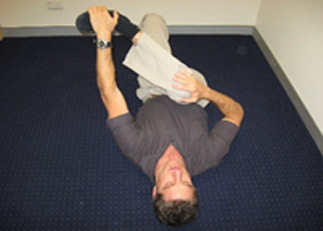
-
Iliopsoas (hip flexors) stretches for snowboarders
Purpose: Target deep muscles within the front of the hip to allow you to turn your snowboard succinctly.
How to do it: Standing, place one foot on a chair behind you. Come down slowly into a lunge position with your front foot out forwards of the body. It is a good idea to rest the stretching knee on a pillow.

-
Calf stretches for snowboarders
Purpose: Target deep muscles below the knee to assist the gluteals in the squatting position.
How to do it: Standing, place both arms outstretched on a wall in front of you. Adopt lunge position whereby your leg out in front of the body is bent and the leg behind the body is straight. Ensure both toes are pointing straight towards the wall.
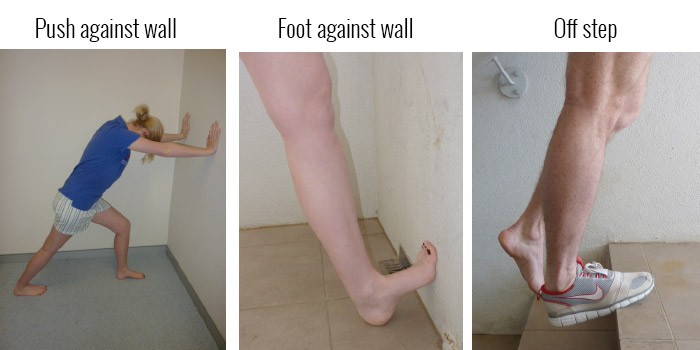
-
Iliotibial band (ITB) stretches for snowboarders
Purpose: Target the band of fascia on the outside of the hip, running down to the knee. If this is tightly wound, your cornering will be negatively affected.
How to do it: Standing, place one leg behind the other so that it is crossing the midline of the body. Turn this foot so that it is on the edge of the sole. Drop this hip out towards the ground. Bring arms overhead, going the opposite way to the hip to enable the side of the hip to stretch.
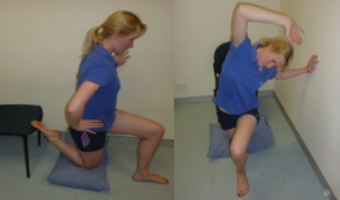
-
Lower back extensors stretches for snowboarders
Purpose: The shock absorber of all the bumps on your snowboard, it is critical to stretch your lower back out before you exercise.
How to do it: a) Lay on your stomach with hands out in front out of you. Push hands into the ground as you lift one segment at a time in your back. b) Known as the “child’s pose” position, have knees bent on the ground as you tuck your head in and ensure arms are outstretched above the body.
Pairing these two together is an excellent way to keep the lower back loose.

-
Shoulder/upper back stretches for snowboarders
Purpose: You use your upper back and shoulders extensively to turn and balance throughout the day whilst snowboarding.
How to do it: a) Lay on your side with hips, knees and ankles stacked on top of one another. Have your arms outstretched at 90 degrees. Without moving your hip, bring your top arm up and over your body to stretch out the shoulder and upper back.

b) Standing, bring one arm across your body and lock it into place with your opposite arm.

-
Hamstring stretches for snowboarders
Purpose: Hamstrings work extensively as you snowboard as they continually shorten and lengthen throughout the cornering process of snowboarding.
How to do it: Lay on the ground, use a towel around the ball of your foot. With your opposite knee bent, use your arms to bring the leg up straight.
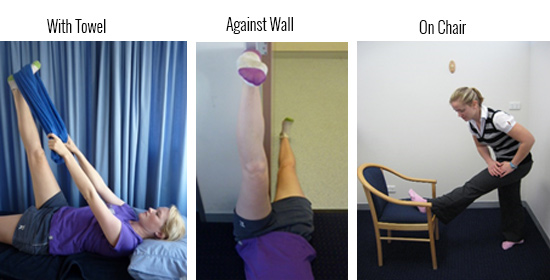
-
Groin stretches for snowboarders
Purpose: The inner thigh muscles act as a group to create a stable base to work off as other muscles are firing.
How to do it: Standing side on to a chair, place one leg up onto the chair. Ensure that both sets of toes are pointing straight. Leaning into the stretching leg accentuates the stretch.
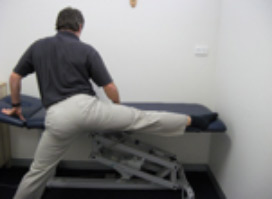
Timing your stretches for snowboarders
As a general rule, we want to be stretching global muscles. What we mean by global, are large muscle groups throughout the body that are about to be put to the test out on the ski fields.
We should be warm before doing these exercises to increase the pliability of the muscles. The aim of the stretch is to increase the extensibility of the muscle.
Individual stretches should be held for 30 seconds. It is a good idea to do the same stretch over 2 or 3 repetitions.
Ideally, our warm-up should include some ballistic movements. This means high velocity and acceleration movements. Whereas our cool down should entail some static stretches. This would entail stretches held for 30-45 seconds.
Conclusion
So there you have it. A guide as to what you should be stretching before getting out on your snowboard. Please note; this is just a guide. This doesn’t take into account a client’s individual history and personal goals. We also need a high level of core strength and cardiovascular fitness. By going through a proper assessment with one of our physiotherapists, we can tailor-make a program to suit your boarding needs! Happy winter everyone!
References
https://en.wikipedia.org/wiki/Snowboarding
http://rjphysio.co.nz/media/thumbnails/blog/image/2014/09/14/7.png.0x240_q90_autocrop_crop-smart_upscale.png
http://physioandpilatesrehab.co.uk/images/exercise-program9.jpg
https://breddydotorg.files.wordpress.com/2012/11/backward-rocking.jpeg
https://s-media-cache-ak0.pinimg.com/originals/cd/2e/8d/cd2e8d833103f52d730d8a4faae30ae5.jpg
http://www.stretchify.com/wp-content/uploads/2013/07/pretzel-stretch.jpg?3ce666
